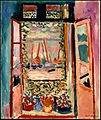Fauvism facts for kids

Les Fauves (pronounced "Lay Fove") was an exciting art movement that started in France in the early 1900s. The name "Fauves" means "The Wild Beasts" in French. This group of artists got this name because they used super bright and bold colors in their paintings, often in ways that weren't realistic. Imagine painting a tree bright blue or a face green! The main leaders of this group were two famous painters, Henri Matisse and André Derain.
These artists were inspired by the strong, bright colors used by earlier painters like Vincent van Gogh and Paul Gauguin. They wanted to show feelings and emotions through their art, not just what things looked like in real life. Their unique style of painting began around 1900. Even though the main group was only together for about three years (from 1905 to 1907), their influence on art has continued to this day. Many artists, even those not officially part of the Fauves, were inspired by their bold use of color.
Contents
What Were Les Fauves?
The Fauves were a group of modern painters in France. They loved to use very strong, pure colors directly from the paint tube. Instead of mixing colors to make them look natural, they used bright reds, blues, greens, and yellows to create powerful feelings in their artworks. They weren't trying to paint things exactly as they saw them. Instead, they used color to express their emotions and make their paintings exciting.
The "Wild Beasts" Name
The name "Les Fauves" came from an art critic named Louis Vauxcelles in 1905. He saw their paintings at an art show called the Salon d'Automne in Paris. He was so surprised by their bright, non-realistic colors and bold brushstrokes that he said it looked like "Donatello among the wild beasts." He meant that a traditional sculpture (by Donatello) was surrounded by these crazy, colorful paintings. The name "Wild Beasts" stuck, and the artists actually liked it!
Key Artists and Their Style
The two most important artists in the Fauvist movement were Henri Matisse and André Derain.
- Henri Matisse was known for his amazing use of color and simple shapes. He believed that color should be used to express feelings and create harmony in a painting. His works often show people, rooms, and landscapes filled with vibrant, flat areas of color.
- André Derain also used very bright colors and strong brushstrokes. He painted many landscapes, especially of places like London and the south of France, making them look lively and energetic with his bold color choices.
Other artists who were part of or influenced by the Fauves included Maurice de Vlaminck, Georges Braque (who later helped create Cubism), and Raoul Dufy. They all shared a love for intense color and a desire to break away from traditional painting rules.
How Long Did Fauvism Last?
The Fauvist movement was quite short-lived as a group. Their main period of working together and exhibiting was from 1905 to 1907. After these few years, many of the artists, including Matisse and Derain, started to explore new styles. However, the ideas of Fauvism – especially the freedom to use color in new and expressive ways – had a huge impact on art that came after it. It opened the door for many other modern art movements.
Related pages
Images for kids
-
Henri Matisse. Woman with a Hat, 1905. San Francisco Museum of Modern Art
-
André Derain, 1906, Charing Cross Bridge, London, National Gallery of Art, Washington, D.C.
-
Henri Rousseau, The Hungry Lion Throws Itself on the Antelope, 1905, oil on canvas, 200 cm × 301 cm, Beyeler Foundation, Basel
-
Robert Delaunay, 1906, L'homme à la tulipe (Portrait de Jean Metzinger), oil on canvas, 72.4 x 48.5 cm. Exhibited at the 1906 Salon d'Autome (Paris) along with a portrait of Delaunay by Jean Metzinger
-
Henri Matisse, Notre-Dame at the end of the Afternoon, 1902, Albright-Knox Art Gallery, Buffalo, New York
-
André Derain, Self-portrait in the Studio, 1903, National Gallery of Australia, Canberra, Australia
-
Henri Matisse, Les toits de Collioure, 1905, oil on canvas, The Hermitage, St. Petersburg, Russia
-
Henri Matisse, Open Window, Collioure, 1905, National Gallery of Art, Washington, DC.
-
André Derain, 1905, Le séchage des voiles (The Drying Sails), 1905, Pushkin Museum, Moscow
-
Maurice de Vlaminck, 1905–06, Barges on the Seine (Bateaux sur la Seine), oil on canvas, 81 x 100 cm, Pushkin Museum, Moscow
-
Georges Braque, 1906, L'Olivier près de l'Estaque (The Olive tree near l'Estaque). At least four versions of this scene were painted by Braque, one of which was stolen from the Musée d'Art Moderne de la Ville de Paris during the month of May 2010.
-
Henri Matisse, Portrait of Madame Matisse (The Green Stripe), 1906, Statens Museum for Kunst, Copenhagen, Denmark
-
Maurice de Vlaminck, The River Seine at Chatou, 1906, Metropolitan Museum of Art
-
Henri Matisse, 1906, Self-Portrait in a Striped T-shirt, Statens Museum for Kunst, Copenhagen, Denmark
-
Othon Friesz, 1907, Paysage à La Ciotat, oil on canvas, 59.9 x 72.9 cm
See also
 In Spanish: Fovismo para niños
In Spanish: Fovismo para niños




















